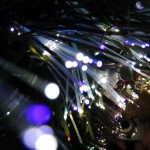Consumers Are Flocking to Fiber Optics
When it comes to the data transfer race, the fiber optic cable is quickly becoming the leader of the pack and an industry standard for all networking needs. And, when compared to the ever-present coaxial cable, fiber optic technology has some unique benefits that place it in a class all its own. With new age networking in mind, here are five reasons why more individuals, companies, cities, and governments are relying on fiber optic cables, as opposed to coaxial:
1. Blazing Fast Bandwidth
Not only does the fiber optic cable carry a higher bandwidth over a longer distance than coaxial, it is also capable of carrying greater amounts of data from transfer to transfer. This is not to say that fiber optic has an infinite bandwidth, but when compared to coaxial, fiber optic simply moves faster and further.
In terms of megahertz per kilometer, the parameters of coaxial cable are roughly 10MHz/km, whereas the parameters for fiber optic cable are over 400MHz/km. For standard distances, this means fiber optic carries bandwidth at breakneck speeds.
And it only keeps getting faster. Google has rolled out Google Fiber in Kansas City, and has plans to bring it to Austin. In an industry where Internet service providers talk in measurements of megabits, Google is promising speeds of one gigabit per second.
2. Electromagnetic Immunity
Unlike copper coaxial, or other cable types that utilize metals, fiber optic cables use light to transmit signals and data. This makes fiber optic cables immune to electromagnetic interference, or EMI. The lack of EMI also opens up a whole range of possibilities for fiber optic usage.
In other words, fiber optic cable is an excellent option in situations where existing cables and electrical equipment are present. Because the core consists of glass, fiber optic cable remain untouched by various other types of electrical and radio interference as well, including power surges.
3. Installation is a Breeze
Because fiber optic cables are smaller in diameter, more flexible, and carry more data than coaxial cables, they are much easier to install. So, whether the installation involves tight spaces or sharp turns, running fiber optic cables through preexisting holes and crowded conduit is less challenging than other options.
Because fiber optic cable is immune to EMI, installation alongside other types of cable is not a problem. Not only that, because the main connections for most Internet service providers are made of fiber optic material, compatibility is not an issue either.
In fact, the entire world is connected via fiber optic cables. Immensely long cables run across the bottom of the ocean, connecting continents and bringing the Internet to most of the inhabited areas of the globe (sorry, Antarctica), and there are plans to continue laying more.
4. Unparalleled Data Security
A fiber optic cable does not emit signals of any kind, which makes data interception almost non-existent. This is due to the fact that the electromagnetic fields produced by fiber optic cables are completely contained within the fiber itself.
Likewise, signal tapping takes an extreme amount of skill and is therefore much less likely to occur than tapping with coaxial cable. And, in the unlikely case a fiber optic cable is tapped, the breach is easily noticeable because the entire cable system fails once the light carried within the fiber leaks.
5. Quickly Decreasing Cost
Although the hardware and installation costs of fiber optic cables are still higher than coaxial, the price is steadily dropping as the technology becomes more common. In the long run, fiber optic cables already cost less in the maintenance department because they are more durable.
When compared to coaxial, the advantages of the fiber optic cable put it in a technologically-advanced class that is simply unrivaled. From a consumer’s standpoint, this affects how quickly you’d be able to access information online, whether it be in the form of downloading files, streaming television shows from Direct TV, video chatting with a friend, or receiving emails.
And, if it serves as any indication of where this technology is headed, fiber optic cables have recently acquired the capability to reach speeds that present-day individual consumers don’t even have a use for yet. Now that’s fast.
